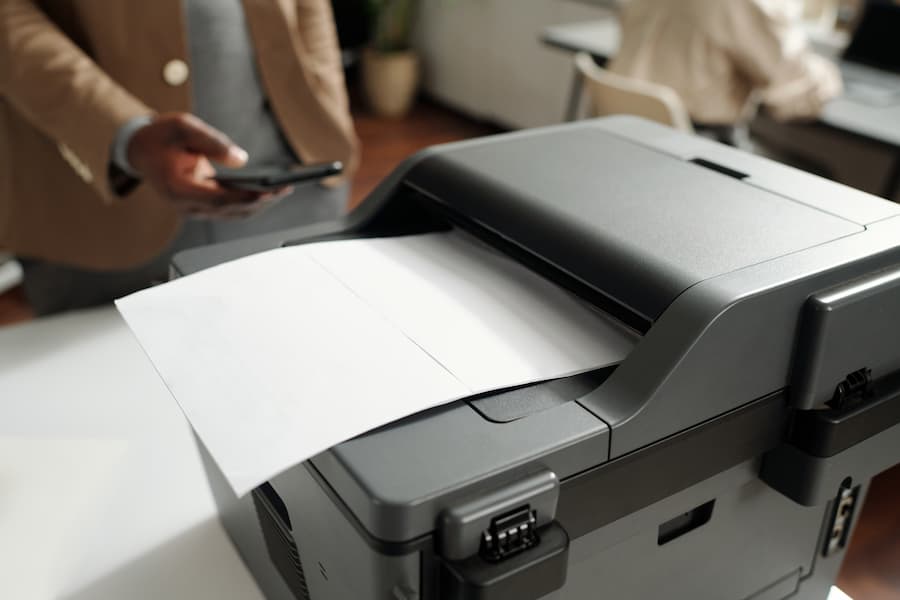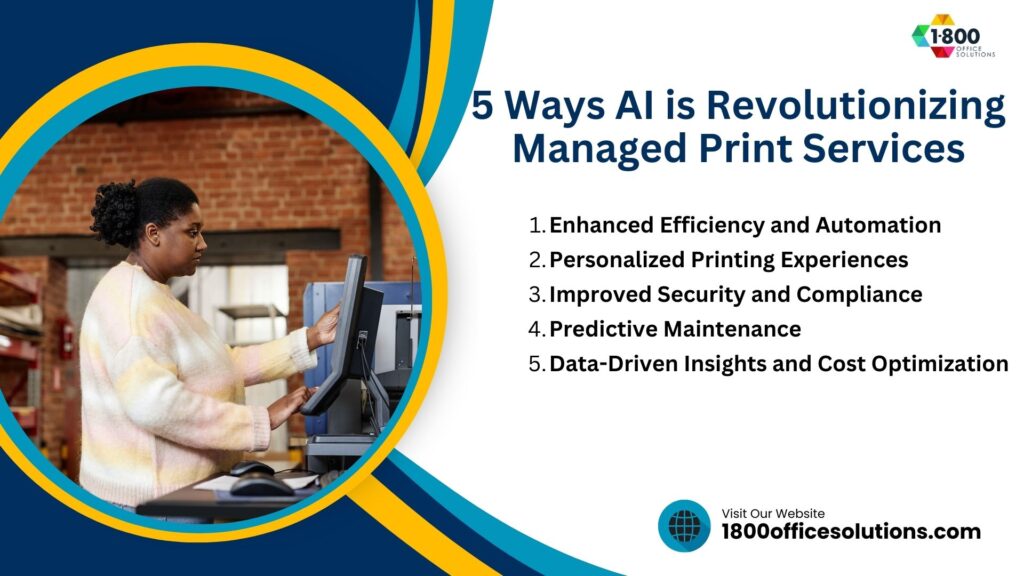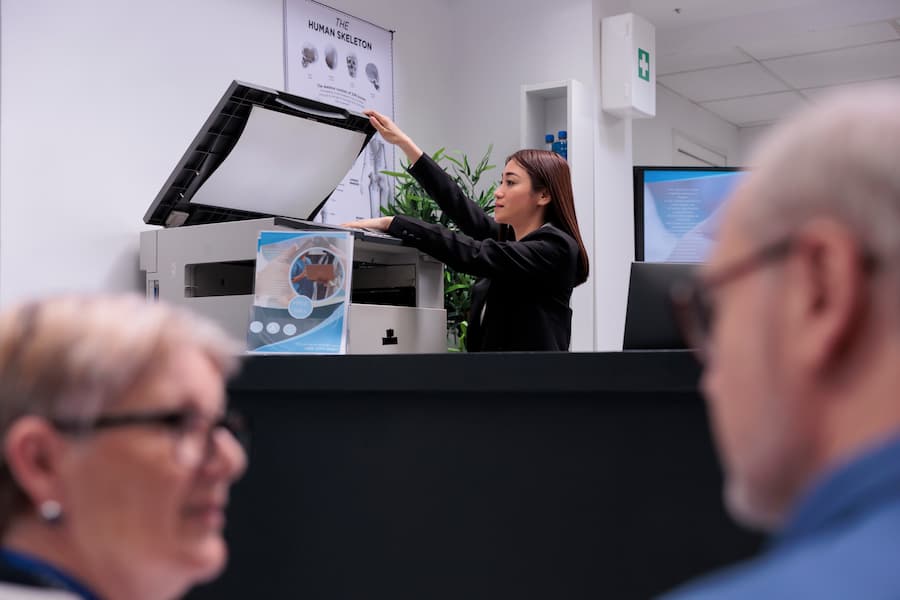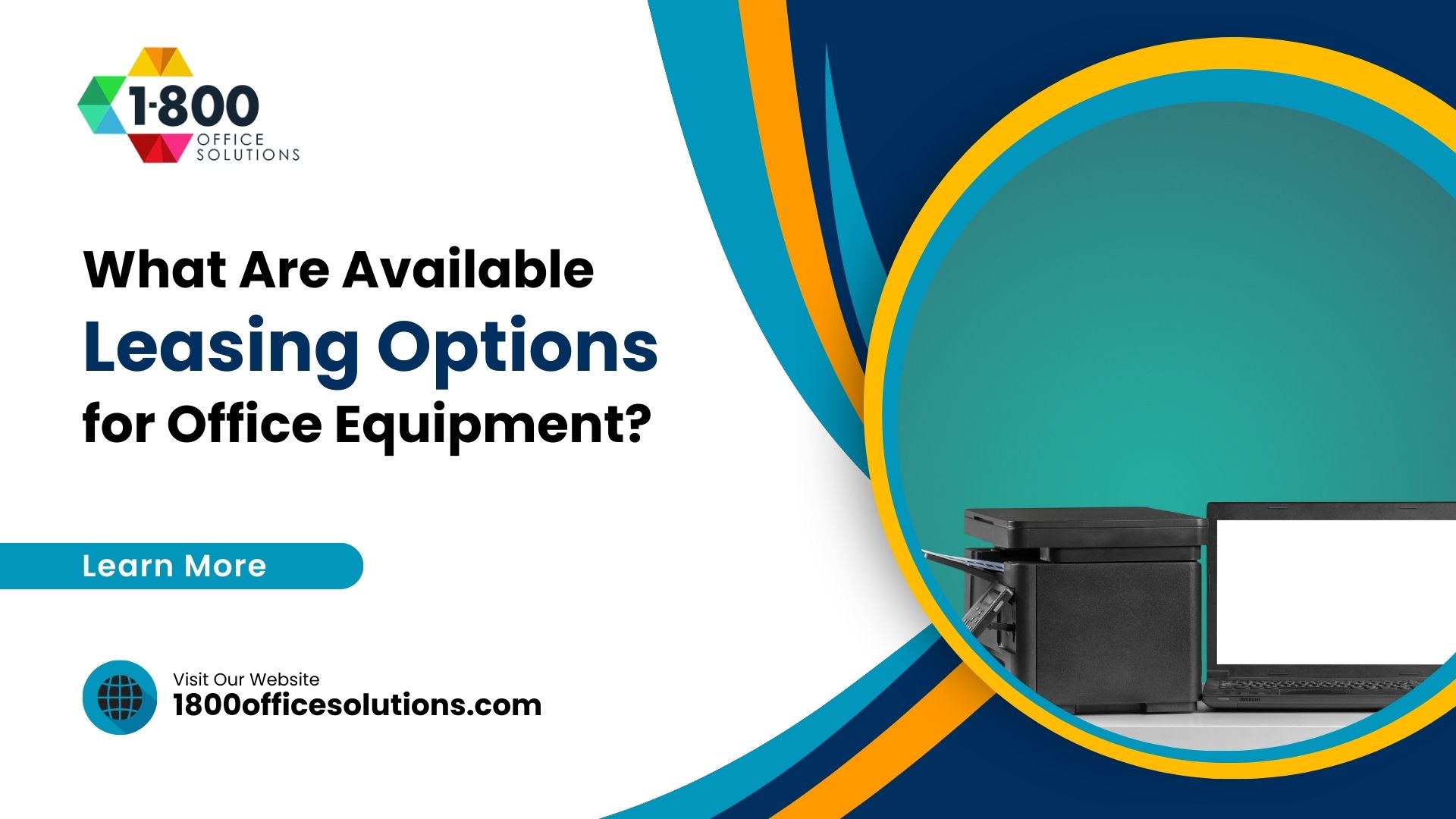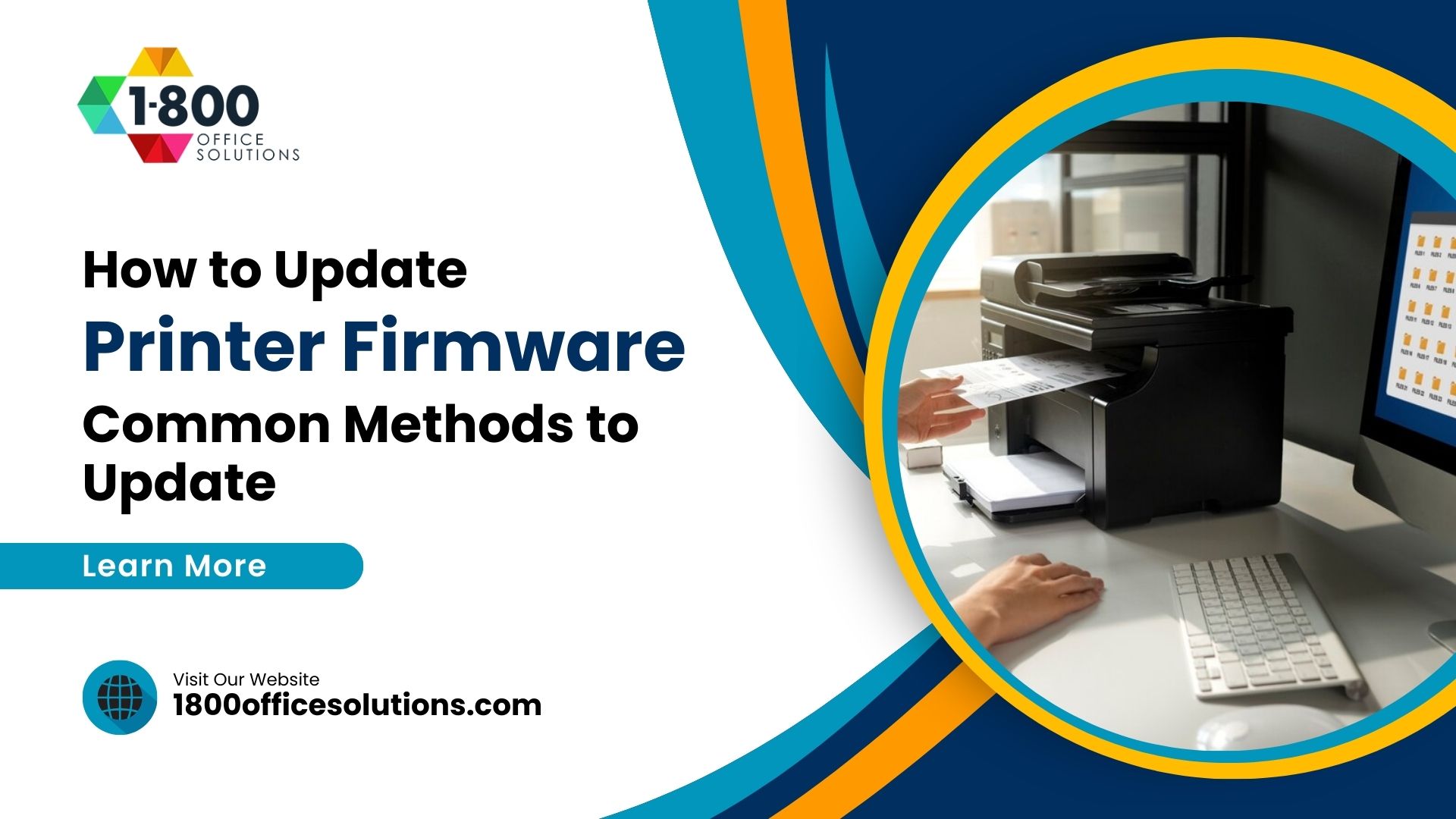Printing and AI: 5 ways Managed Print Industry is Changing
Printing and AI
In business companies are constantly seeking ways to streamline operations and reduce costs. Managed Print Services (MPS) offer a solution by taking the burden of printer management off your shoulders. MPS providers handle everything from toner refills to printer maintenance, ensuring a smooth and efficient printing experience.
Artificial intelligence (AI), a rapidly developing field of computer science, is transforming industries worldwide. AI algorithms can learn and adapt, automating tasks and making intelligent decisions. This article explain to you how AI is revolutionizing the Managed Print Services landscape.
The Rise of AI in Printing
What is AI in Printing
AI, or Artificial Intelligence, is revolutionizing the printing industry by bringing intelligence and automation to various stages of the printing process. Here’s a breakdown of how AI is impacting printing:
-
Automation: Repetitive tasks like pre-press checks, toner ordering, and print job routing are becoming automated by AI algorithms, freeing up human resources for more strategic work.
-
Optimization: AI analyzes printing data to identify areas for improvement. This can involve optimizing print quality based on document type, reducing waste through layout adjustments, or streamlining workflows for faster turnaround times.
-
Personalization: AI personalizes the printing experience. Imagine marketing materials with variable data printing (VDP) that use customer data to create unique content for each recipient. AI can also personalize print settings for each job, maximizing quality and efficiency.
-
Security: AI safeguards sensitive information during printing. It can monitor printing activities, detect suspicious patterns, and enforce printing policies within organizations.
-
Predictive Maintenance: AI analyzes historical data and sensor readings from printers to predict potential equipment failures. This allows for preventive maintenance before problems arise, minimizing downtime and ensuring smooth printing operations.
-
Data-Driven Insights: AI analyzes vast amounts of printing data to identify cost-saving opportunities. This might involve switching to more economical toner cartridges or encouraging double-sided printing.
AI is transforming printing from a manual process to an intelligent system, offering businesses greater efficiency, security, and cost savings.
Historical Glimpse into AI and Printing
The integration of AI into printing has been a gradual process. Early applications focused on automating basic tasks like pre-press checks for image quality and font consistency. Over time, AI capabilities have become more sophisticated. For instance, Xerox pioneered the concept of self-monitoring printing presses in the early 2000s. These presses utilize sensors and AI to automatically adjust settings for optimal print quality, minimizing human intervention Xerox and Artificial Intelligence.
5 Ways AI is Revolutionizing Managed Print Services
1. Enhanced Efficiency and Automation
MPS providers are leveraging AI to automate repetitive tasks within the printing process, freeing up human resources for more strategic activities. For instance, AI can automatically order toner cartridges when supplies are low, eliminating the need for manual monitoring and ensuring uninterrupted printing operations. Additionally, AI algorithms can analyze printing workflows and identify areas for improvement. By optimizing print job routing and eliminating unnecessary steps, AI helps to streamline processes and reduce overall printing costs.
In addition to automating routine tasks, AI can also assist with printer maintenance and troubleshooting. Real-time data analysis by AI algorithms can detect potential printer issues before they occur, enabling proactive maintenance and minimizing downtime.
2. Personalized Printing Experiences
The power of AI extends beyond automation. MPS providers are utilizing AI to personalize the printing experience for their clients. By analyzing user data and printing habits, AI can tailor print settings to optimize quality and efficiency. For example, AI can automatically adjust print resolution based on the type of document being printed (text-based vs. image-heavy).
Furthermore, AI is paving the way for advancements in variable data printing (VDP). VDP allows for the creation of customized marketing materials, such as direct mail pieces, with unique content for each recipient. By integrating AI with VDP technology, MPS providers can personalize marketing campaigns for maximum impact, potentially leading to higher conversion rates.
AI also holds the potential to create interactive print experiences. Imagine a brochure that comes alive when scanned by a smartphone camera, overlaying digital content or triggering augmented reality (AR) features. While still in its early stages, AI-powered interactive printing has the potential to revolutionize the way businesses engage with their audiences.
3. Improved Security and Compliance
In printing security is also important. AI can play a crucial role in safeguarding sensitive information during the printing process. AI algorithms can monitor printing activities and identify suspicious patterns, such as unauthorized access attempts or attempts to print confidential documents. This proactive approach helps to mitigate security risks and ensure compliance with data privacy regulations.
Furthermore, AI can be used to enforce printing policies within an organization. For instance, AI can be used to enforce printing policies within an organization. AI can automatically restrict color printing for specific users or departments, helping to control printing costs and reduce unnecessary use of color toner. Additionally, AI can track printing activities by individual users, enabling organizations to identify potential security breaches or wasteful printing habits.
4. Predictive Maintenance and Reduced Downtime
Printers are complex machines, and unexpected breakdowns can disrupt workflow and productivity. Here’s where AI steps in with its predictive capabilities. By analyzing historical printing data and sensor readings from printers, AI algorithms can forecast potential equipment failures. This predictive analytics allows MPS providers to schedule preventative maintenance before problems arise, minimizing downtime and ensuring smooth printing operations.
The benefits of AI-powered predictive maintenance go beyond just preventing breakdowns. By proactively addressing potential issues, MPS providers can extend the lifespan of printing equipment and reduce overall maintenance costs. This translates to significant savings for businesses that rely heavily on printing.
5. Data-Driven Insights and Cost Optimization
AI doesn’t just automate tasks; it also unlocks valuable insights from printing data. MPS providers are leveraging AI to analyze vast amounts of printing data, including user behavior, print job volume, and toner usage. These insights can be used to identify areas for cost optimization.
For instance, AI can analyze printing habits within an organization and recommend cost-saving measures. This might involve switching to more economical toner cartridges or encouraging double-sided printing for certain document types. Additionally, AI can help identify underutilized printers and streamline printer fleets, potentially leading to hardware consolidation and further cost savings.
Overall, AI empowers MPS providers to offer data-driven recommendations to their clients, helping businesses optimize their printing operations and maximize their return on investment (ROI).
Future of AI in Printing
The future of AI in printing is brimming with exciting possibilities. One emerging area is 3D printing optimization. AI algorithms can analyze 3D models and printing parameters to identify potential issues and suggest improvements, leading to faster printing times, higher quality prints, and reduced material waste. Additionally, AI advancements in cybersecurity can further safeguard printing processes. Sophisticated algorithms can detect and thwart unauthorized access attempts or malware infiltration, protecting sensitive data throughout the printing workflow.
However, AI adoption in the printing industry isn’t without its challenges. Data privacy concerns are paramount. Businesses must ensure that AI-powered MPS solutions handle customer data responsibly and adhere to strict data security regulations. Another potential challenge is job displacement. As AI automates tasks, some printing industry positions may be affected. However, the focus will likely shift towards roles that require human expertise to manage and oversee AI systems, creating new opportunities in the printing sector.
Benefits of AI for Businesses Using MPS
Businesses that leverage AI-powered MPS solutions can reap significant benefits. Increased efficiency through automation translates to lower printing costs and reduced administrative burdens. Predictive maintenance minimizes downtime and ensures smooth printing operations. Data-driven insights empower businesses to optimize printing workflows and identify cost-saving opportunities. Enhanced security safeguards sensitive information and protects businesses from data breaches. Overall, AI-powered MPS solutions offer a compelling combination of efficiency, cost savings, and security for businesses of all sizes.
What People Also Ask
What is the difference between AI and traditional printing technologies?
Traditional printing technologies rely on pre-programmed instructions to complete tasks. In contrast, AI leverages machine learning algorithms that can learn and adapt over time, enabling automation, optimization, and intelligent decision-making within the printing process.
How can businesses ensure data security when using AI-powered MPS?
Look for MPS providers that prioritize data security. These providers should have robust security protocols in place and adhere to industry-standard data privacy regulations. Businesses can also inquire about the specific ways AI handles customer data within the MPS solution.
Will AI lead to job losses in the Managed Print Industry?
While AI may automate some repetitive tasks, it’s unlikely to completely replace human jobs in the printing industry. Instead, AI is likely to create a shift in skillsets, requiring a focus on managing and overseeing AI systems. New opportunities will emerge in areas like data analysis and cybersecurity to support AI integration.
How can businesses get started with AI-powered MPS solutions?
Consult with reputable MPS providers who offer AI-integrated solutions. Discuss your specific printing needs and inquire about how AI can optimize your printing operations. Many MPS providers offer free consultations or trials, allowing businesses to experience the benefits of AI-powered printing firsthand.
Conclusion
The integration of AI is undeniably transforming the Managed Print Services landscape. AI empowers MPS providers to offer businesses a more efficient, secure, and cost-effective printing experience. As AI technology continues to evolve, we can expect even more innovative applications to emerge, further revolutionizing the printing industry. By embracing AI, businesses can stay ahead of the curve and unlock the full potential of their printing operations.



